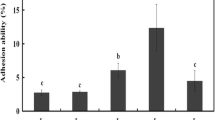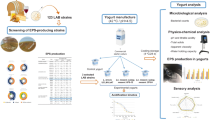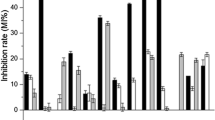Abstract
A novel strain of lactic acid bacteria Pediococcus pentosaceus P 773 was isolated from spoiled beer and identified by means of 16S rDNA sequence analysis. The ability to assimilate lactose as a sole carbon source as a specific feature for this strain was detected and confirmed on dairy substrates. In the presence of sucrose containing substrates (sucrose, raffinose) this P. pentosaceus P 773 lactose-positive strain produced a complex of extracellular polysaccharides (Qp = 0.08 g/l/h) with a molecular mass about 2,000 kDa composed by glucose and fructose residues at a ratio 3:1, respectively. These exopolysaccharides were capable to stimulate the growth rate and biomass productivity of common constituent cultures of probiotic dairy starters (Bifidobacterium lactis, Lactobacillus acidophilus, Streptococcus thermophilus) as well as were assimilated as a sole carbon source by these strains. The present study confirmed the presence of lactose-positive and exopolysaccharide-producing strain of P. pentosaceus in natural environment which could be used as a starter culture to impart more functional attributes to fermented food.


Similar content being viewed by others
References
Leroy F, De Vuyst L (2004) Trends Food Sci Technol 15:67–78
Russ-Madiedo P, De los Reyes-Cavilan CG (2005) J Dairy Sci 88:843–856
In LJ, Jiang ST (2001) J Food Sci 66:742–746
Luchansky JB, Glass KA, Harsono KD, Degnan AJ, Faith NG, Cauvin B, Baccus-Taylor G, Arihara K, Bater B, Maurer AJ (1992) Appl Environ Microbiol 58:3053–3059
Spicka J, Kalac P, Bover-Cid S, Krizek M (2002) Eur Food Res Technol 215:509–514
Kleinschmit DH, Kung L (2006) J Dairy Sci 89:3999–4004
Roccach M, Tully T (1999) Food Sci Tech Int 5:243–249
Simpson WJ, Taguchi H (1995) The genus Pediococcus, with notes on the genera Tetratogenococcus and Aerococcus. In: Wood BJB, Holzapfel WH (eds) The genera of Lactic acid Bacteria. Chapman & Hall, London, pp 125–172
Smitinont T, Tanasakul C, Tanasupawat S, Keeratipibul S, Navarini L, Bosco M, Cescutti P (1999) Int J Food Microbiol 51:105–111
Caldvell SL, McMahon DJ, Oberg GJ, Broadbent JR (1996) Appl Environ Microbiol 62:936–941
Garvie EI (1986) Genus Pediococcus. In: Sneath PHA, Mair NS, Sharpe ME, Holt JG (eds) Bergey’s manual of systematic bacteriology, vol 2, 9th edn. The Williams & Wilkins, Baltimore, pp 1075–1079
Bengmark S, Gil A (2006) Nutr Hosp 21:72–84
Brink M, Fraser T, Todorov SD, Vaz-Velho M, Senekal M, Dicks LMT (2003) Electron J Environ Agric Food Chem 2:504–509
Gardiner GE, Casey PG, Casey G, Casey G, Lynch PB, Lawlor PG, Hill C, Fitzgerald GF, Stanton C, Ross P (2004) Appl Environ Microbiol 70:1895–1906
Bhowmik T, Marth EH (1990) J Dairy Sci 73:859–866
Bekers M, Marauska M, Laukevics J, Grube M, Vigants A, Karklina D, Skudra L, Viesturs U (2001) Food Biotechnol 15:1–12
Klaenhammer TR (1984) Adv Appl Microbiol 30:1–29
Riebel WJ, Washington JA (1990) J Clin Microbiol 28:1348–1355
Collins MD, Williams AM, Wallbanks S (1990) FEMS Microbiol Lett 58:255–262
Welman AD, Maddox IS (2003) Trends Biotechnol 21:269–274
Semjonovs P, Zikmanis P (2007) J Food Technol 5:123–130
Tieking M, Korakli M, Ehrmann M, Gaenzle MG, Vogel RF (2003) Appl Environ Microbiol 69:945–952
Martensson O, Biorklund M, Lambo A, Duenas-Chasco M, Irastorza A, Holst O, Norin E, Welling G, Oste R, Onning G (2005) Nutr Res 25:429–442
Dal Bello F, Walter J, Hertel C, Hammes WP (2001) Syst Appl Microbiol 24:232–237
Llauberes RM, Richard B, Lonvaud A, Dubourdieu D, Fournet B (1990) Carbohydr Res 203:103–107
Manca de Nadra MC, Strasser de Saad AM (1995) Int J Food Microbiol 27:101–106
Di Cagno R, De Angelis M, Limitone A, Minervini F, Carnevall P, Corsetti A, Gaenzle M, Ciati R, Gobbetti M (2006) J Agric Food Chem 54:9873–9881
De Man JC, Rogosa M, Sharpe ME (1960) J Appl Bacteriol 23:130–135
Andersone I, Auzina L, Vigants A, Mutere O, Zikmanis P (2004) Eng Life Sci 4:56–59
Bekers M, Laukevics J, Upite D, Kaminska E, Vigants A, Viesturs U, Pankova L, Danilevics A (2002) Proc Biochem 38:701–706
Morris DL (1948) Science 107:254–255
Sedmak JJ, Grossberg SE (1977) Anal Biochem 79:544–552
Van Geel-Schutten GH, Faber EJ, Smit E, Bonting K, Smith MR, Ten Brink B, Kamerling JP, Vliegenthart JFG, Dijkhuizen L (1999) Appl Environ Microbiol 65:3008–3014
McIntosh M, Stone BA, Stanisich VA (2005) Appl Microbiol Biotechnol 68:163–173
Robyt JF, Walseth TF (1978) Carbohydr Res 61:433–445
Semjonovs P, Marauska M, Linde R, Grube M, Zikmanis P, Bekers M (2004) Eng Life Sci 5:433–437
Acknowledgments
This study was supported by the European Social Foundation, Project ESSS 2004/3, Contract No. 2004/0001/VPD1/ESF/PIAA/04/NP/3.2.3.1/0001/0063.
Author information
Authors and Affiliations
Corresponding author
Rights and permissions
About this article
Cite this article
Semjonovs, P., Zikmanis, P. Evaluation of novel lactose-positive and exopolysaccharide-producing strain of Pediococcus pentosaceus for fermented foods. Eur Food Res Technol 227, 851–856 (2008). https://doi.org/10.1007/s00217-007-0796-4
Received:
Revised:
Accepted:
Published:
Issue Date:
DOI: https://doi.org/10.1007/s00217-007-0796-4




